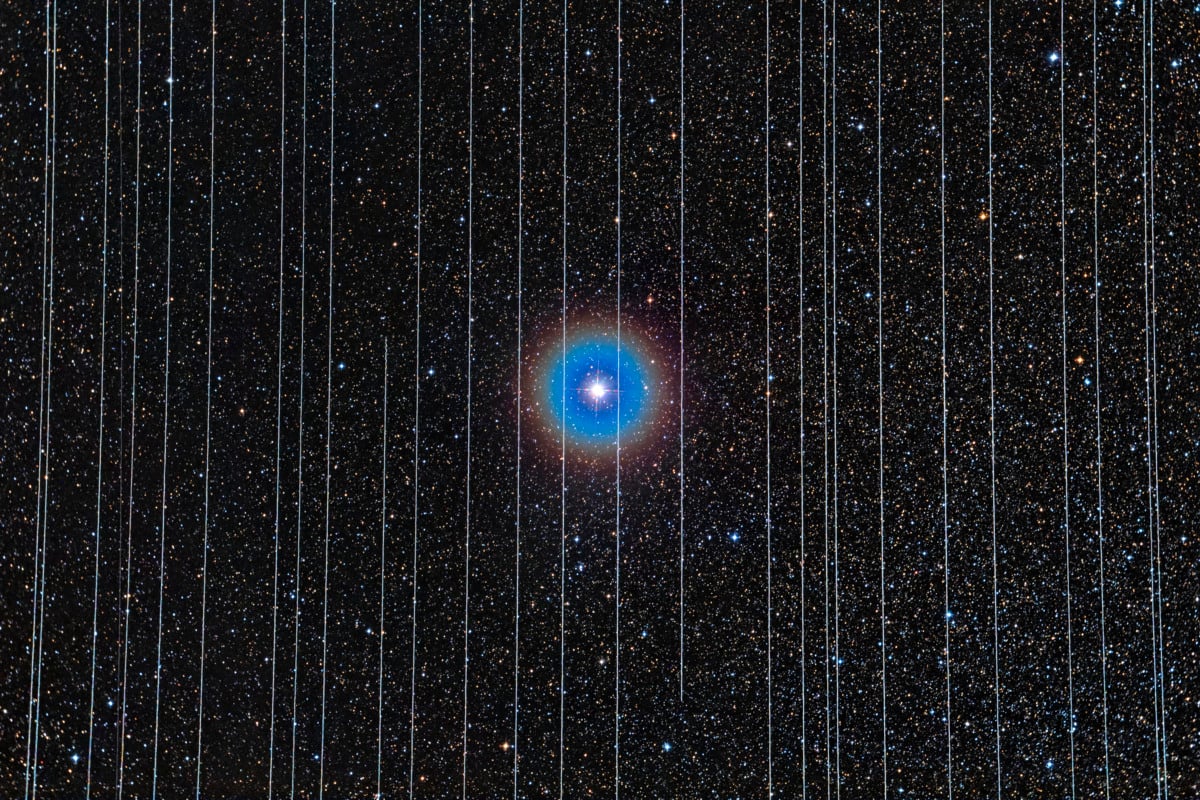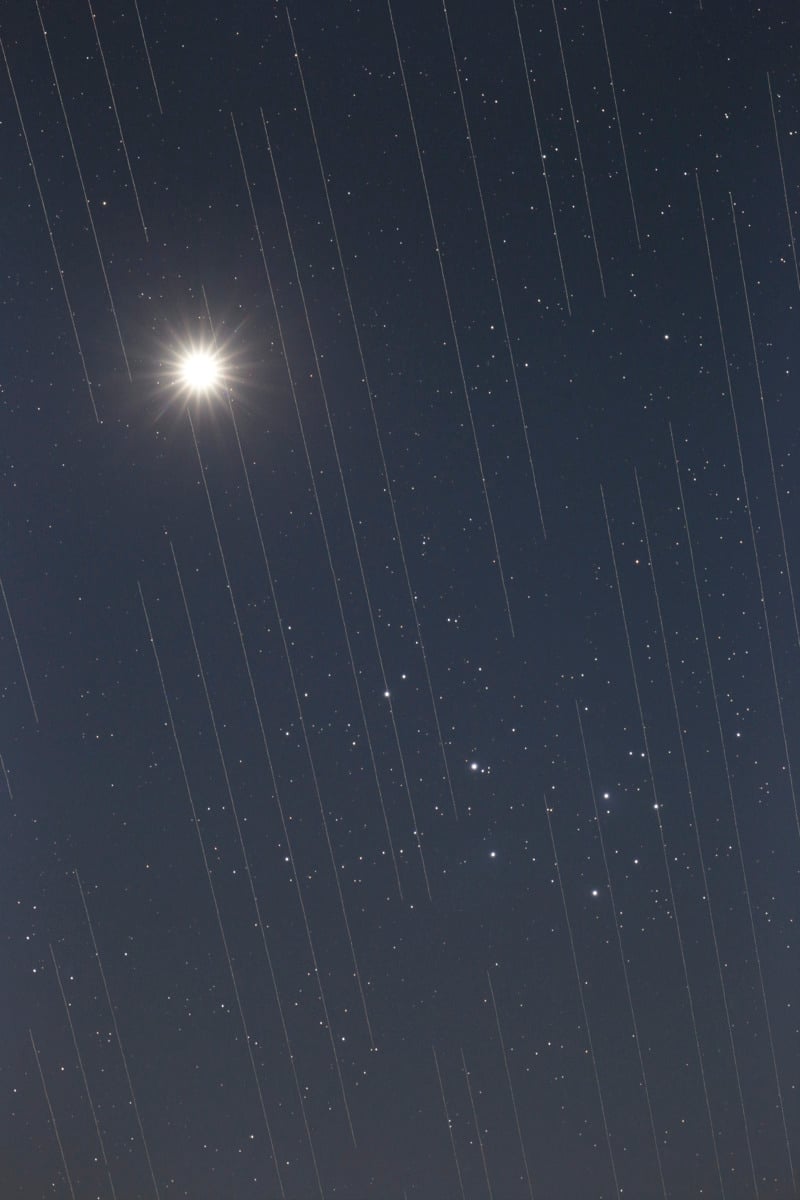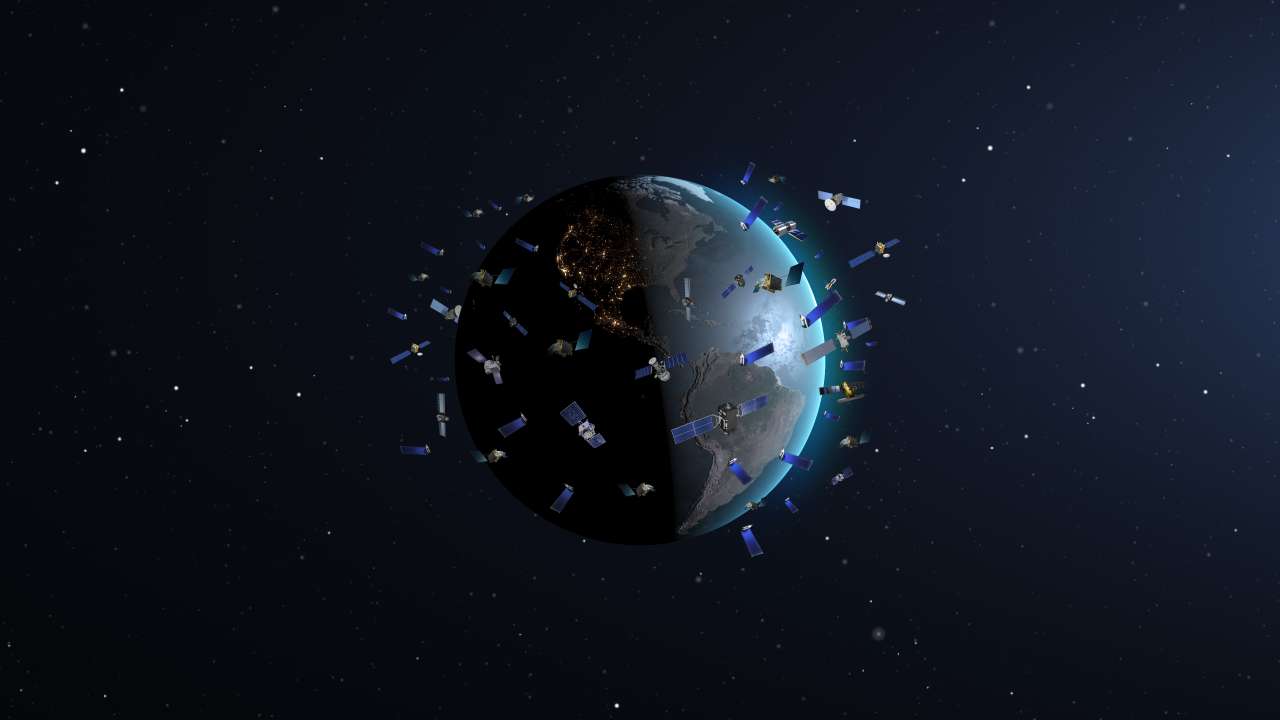
Who Owns the Night Sky?

The following originally appeared as an article in Nightscape #106 (December 2021) written by Megan Eaves. To enjoy new issues of Nightscape all the time, become a member.
In March 2020, as the world descended into COVID-19 lockdown, I began hosting an online event called #Starentine, leading social media users in stargazing from wherever they were in the world through their windows, urban balconies, back gardens, and fire escapes. The event was picked up by a few news outlets and we soon had participants from Italy to Kazakhstan and Australia to New England. People were connecting with the night sky under the worst circumstances and finding solace under the stars. Many were also noticing the light pollution around their homes for the first time.
After one session, I received a panicked message from a participant worried about a series of strange lights they had seen passing through the night sky at oddly regular intervals.
“I thought it might be a satellite, but it wasn’t just one. There were so many lights! I don’t want to sound crazy, but I really thought it was an alien invasion,” they admitted.
I quickly explained that we were (disappointingly) not being invaded by aliens. The lights were, in fact, satellites – scores of them; a new type being sent up in “megaconstellations” (string-of-pearls formations) by Elon Musk’s company, Starlink, to provide internet to rural areas.
History of satellites
The most basic definition of a satellite is anything orbiting a celestial body. The Moon is a satellite of Earth, as Europa is of Jupiter. All planets are satellites of a star. In 1957, the Soviet Union launched the first human-made, artificial satellite, Sputnik 1, into orbit from western Kazakhstan. Its batteries lasted for three weeks, and it continued to orbit for two months before eventually crashing back into Earth’s atmosphere.
Sputnik 1 was the first in a series of satellites sent up by both the Soviet Union and the United States and it launched a race for who could put a human into space first. In 2021, the Space Race has taken a new trajectory as, for the first time, commercial operators like SpaceX, OneWeb, and Project Kuiper are vying to put many thousands more artificial satellites into lower Earth orbit (LEO) and beyond.
The industrialization of space
In 2018, a few thousand operational satellites orbited the Earth. SpaceX’s Starlink satellites launched in May 2019 – the first 60-strong megaconstellation of a total of 12,000 approved by the US Federal Communications Commission (FCC). It is estimated that, by 2030, there may be more than 100,000 satellites in orbit, the vast majority owned and operated by private firms.
This is a rapidly moving industry with very little oversight. There is currently no national or international regulation of on-orbit activities of any kind beyond the 1967 Outer Space Treaty, which only governs weapons and general concepts of due regard, harmful contamination, and harmful interference. No treaty or law limits how many satellites can be orbited.
Aparna Venkatesan is a cosmologist researching the impacts of megaconstellations, particularly their effects on Indigenous communities (she was also the keynote speaker at IDA’s Global Conference this November). In June 2020, Aparna was one of 40 experts who came together for SATCON1, a workshop to assess the impact of satellite constellations and possible mitigation strategies. Four working groups were formed focused on observations, software (algorithms), community engagement, and policy.
This year, SATCON2 addressed implementing those strategies and recommendations. Adjacently over the past two years, the UN Office for Outer Space Affairs (UNOOSA) held its Dark and Quiet Skies for Science and Society conferences on the growing threat of artificial light at night, and dedicated a full day to satellite megaconstellations.

Impacts of satellites
The most well-publicized impact of the new megaconstellations is visual: astronomers and astrophotographers capturing light streaks that disrupt images and scientific data, like the ones shown on this issue’s cover. But their effects go far beyond optical intrusion. There are predicted to be dramatic increases in space debris, radio frequency interference, orbital traffic and collisions, environmental fallout in the upper atmosphere or oceans after satellite decommissioning, and increasing global sky brightness.
A June 2021 paper by researchers including John Barentine and Salvador Bará studied increased sky glow caused by sunlight reflected and scattered by orbiting space objects. The preliminary estimates showed an increase of up to 10% over night-sky brightness caused by natural sources of light, based upon the existing number of satellites in orbit. This is already the critical limit adopted in 1979 by the International Astronomical Union for the light pollution level not to be exceeded at the sites of astronomical observatories. By 2030, they projected a 25 fold increase in the number of objects in low earth orbit. That equates to an increase in night-sky brightness of 250% above the natural background. As noted in the Satcon2 report, “if this scenario is fully realized, it would … [diminish] the number of stars visible to the unaided eye by a factor of about two.”
Olivier Hainaut, an astronomer at the European Southern Observatory (ESO), and his team ran a simulation of 64,000 satellites and found that overall sky brightness would increase by about 0.3%. That increase could reach 4%, with some regions seeing a 40% increase in case all the 64,000 satellites were ground into dust through catastrophic collisions.
In basic terms, satellites cause light pollution and pose a major threat to the visual enjoyment of the night sky and the study of the cosmos from Earth. Worse, satellites orbit the whole planet and can cause an increase in skyglow over otherwise protected areas, such as International Dark Sky Places.
Commercial megaconstellations also pose risks to observation satellites with a scientific remit. For example, in 2019, the European Space Agency (ESA) had to move an observation satellite to avoid colliding with a Starlink satellite, after failing to reach SpaceX by e-mail. And when the vast numbers of megaconstellations reach the end of their relatively short lifespans (3-4 years), they become space debris waiting to collide with important science satellites and even crewed launches.
Together, all of this paints a concerning picture when combined with research published in September by Alejandro Sánchez de Miguel at the University of Exeter. It was the first study of global light emissions between 1992 and 2017 and found that light pollution has increased by at least 49% over 25 years globally, with estimates of up to 400% in some areas.
Cultural and biological heritage of the night sky
The unpolluted night sky is a critical part of many Indigenous cultures and histories. For example, the cosmology of Aboriginal Australians includes night-sky constellations formed of the dark patches in between stars, which are already being interrupted by the presence of skyglow and satellite streaks. An October 2021 Vice article quoted a number of Indigenous leaders and community members as calling megaconstellations a form of “astrocolonialism”.
In a recent paper in Nature Astronomy, cosmologist Aparna Venkatesan wrote that “the manner and pace of ‘occupying’ near-Earth space raises the risk of repeating the mistakes of colonization on a cosmic scale. We must consider the impact of satellite constellations, and related future initiatives, on the essential human right to dark skies and on cultural sky traditions.”
Beyond the human impacts, there are significant effects on other living things. IDA Board of Directors member Kevin Gaston, Professor of Biodiversity & Conservation at the University of Exeter, UK, says that most of the biodiversity that we are familiar with is fundamentally controlled by natural light cycles and has been for most of the duration of life on Earth. “We shouldn’t be surprised when we start messing with those cycles, that most organisms are going to respond.” He also says we need to see funding calls for research into the unknown consequences of megaconstellations and how they can be mitigated.

Satellites: good or bad?
As with artificial light at night, the question of satellites is complex. Observation satellites offer important data about Earth’s surface, weather, and climate change. Speaking at the 2021 UN Climate Change Conference (COP26), Jörg Schulz, Climate Service and Product Manager at the European Organisation for the Exploitation of Meteorological Satellites said, “Long-term sustained observations from space are key for climate monitoring and we need to do everything to maintain them.”
Satellites do a lot of good. They allow us to study life in space and allow for deep-space astronomical observing. Both the International Space Station and Hubble Space Telescope are satellites.
Megaconstellations themselves offer internet connectivity to rural and underserved communities where fiber broadband might be painstaking to install. But given these are the same communities whose cultural heritage they also often put at risk, the balance and trade-offs must be considered carefully.
Who owns the night sky?
I asked Connie Walker, a scientist at the National Science Foundation (NSF)’s astronomy center, NOIRLab, co-chair of the SATCON2 organizing committee, and IDA Board of Directors member, why this issue is important for lovers of a dark night sky. She told me, “Everyone who enjoys the night sky and/or uses space as a resource should consider the various ways satellite constellations impact humanity. The goal for the use of space should be a shared vision that supports and respects all of its users.”
So who owns the night sky? The answer seems simple to me. No one does, and therefore we must collectively care for the sky as a global commons. When taken with a broader view toward climate change, global exploitation, the patriarchy, colonialism, unmitigated growth, extractive industry, and environmental destruction, as well as advancement, progress, and equality, we see the interconnectedness of everything.
Human beings have a fundamental responsibility to respect and protect the planet, indeed the universe, we inhabit — not as owners but as stewards with the technology, consciousness, science, heritage, and emotions to understand how.
As NASA astronaut Ron Garan so eloquently put it during the Global Closing of IDA’s 2021 Under One Sky Conference: “We are all crew members aboard ‘Spaceship Earth’ and need to think of each other as fellow crew members, all working together to protect our ship”
How to get involved in this issue
Below are IDA’s principles for preserving the quiet enjoyment of the night sky and protecting the general public from the impacts of megaconstellations. You can join IDA in calling for a pause in further megaconstellation launches.
- Stewardship of the night sky is a shared responsibility that requires participation and consultation with all stakeholders.
- The cumulative impact on night sky brightness attributed to satellites does not exceed 10 percent above natural background levels.
- Maintained satellite brightness is below the threshold for detection by the unaided eye.
- Satellite visibility is an unusual occurrence.
- Launch schedules and orbital parameters are made publicly available in advance.
Adopted January 2020. Amended September 2021.


















